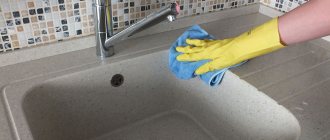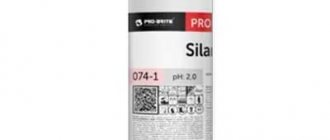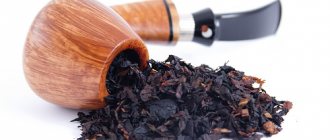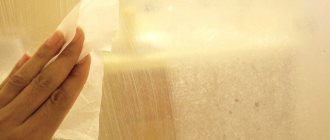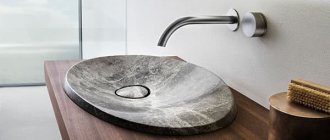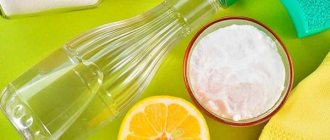What cleaning products should be used to clean sinks and products made from artificial stone? How should they be properly cared for, cleaned, and what should you pay attention to when choosing a detergent composition? Every day this question becomes more relevant, because products (sinks, countertops) made from this material are gaining more and more popularity.
To answer this question, it is necessary, first of all, to become familiar with the features of artificial stone. It has good strength and moisture resistance, and tolerates exposure to a variety of chemical reagents. However, you need to take into account the fact that not all detergent compositions are perfect for cleaning a variety of products made from natural or artificial stone.
The editors of the YaNashla website, taking into account the advice and reviews of most consumers, have prepared for your attention a rating of the best, high-quality products from popular manufacturers for cleaning a variety of products made from artificial stone.
Do I need to clean artificial stone?
Artificial stone is small granite or quartz chips glued together with polymer resins. The finished material is painted and poured into the shape of a shell.
Like any other material, artificial stone requires regular maintenance. Over time, the surface of the sink or sink becomes contaminated with limescale contained in the water, and also becomes covered with stains or greasy marks.
To keep the sink clean, after each use, wash the surface with any dishwashing detergent and wipe dry. If more stubborn dirt appears on the sink, use suitable chemicals or improvised means to clean it.
Care and preventive measures
To prevent serious contamination and damage, use these helpful tips:
- limescale appears on composites all the time. It becomes noticeable on dark sinks. Remove it regularly so that you don’t have any difficulties cleaning it later;
- On light-colored items, stains appear quickly. Fruit and vegetable juices, tea and coffee always leave dark marks that need to be removed in time. If this is not done, dirt will begin to eat into the surface and stains will appear on it;
- If your kitchen or bathroom faucet is dripping, the sink bowl will quickly become rusty. Install high-quality faucets and promptly replace old plumbing fixtures with new ones;
- Sometimes you can't do without a hot pot in the sink. The composite “tolerates” such treatment, but if it becomes regular, it will lead to premature wear of the surface;
- Do not cut meat or vegetables in the sink. This will help avoid deep scratches.
General cleaning rules
For daily sink care, use gel or cream products, as well as dishwashing detergent. Action plan:
- Apply dish detergent to a slightly damp, clean sponge and lather it up.
- Remove grease stains from the coating.
- Rinse off the substance with warm water.
- Apply cleaning gel to the sponge.
- Wipe the bottom and sides of the sink.
- Leave the product on for 15-20 minutes.
- Rinse thoroughly with warm water.
- Dry the sink with a kitchen towel.
It is highly recommended not to wash the sink with too hot water. Composite material is not able to withstand high temperatures or temperature changes. Otherwise, the surface may crack and chips will appear on the sink.
General rules for cleaning and operation
Products that can be used to clean stone sinks should be in the form of creams or liquids. Cream or liquid should be applied to the bottom and walls, wait a little and rinse with water. The weekly cleaning sequence is as follows:
- treat the sink with dishwashing gel to remove grease;
- remove strong stains separately;
- apply cream or liquid to the walls and bottom;
- wait 15-20 minutes;
- wash off the product;
- Wipe the sink with a dry and soft cloth.
Cleaning compounds should be washed off with moderately warm water. Never try to deal with stains by pouring boiling water into the sink. Small cracks will quickly appear on the surface, which will eventually lead to surface cracking and chipping. It is impossible to eliminate them without the use of special means.
Temperature changes have no less detrimental effects on composites. You cannot put a hot pan on the stove in the sink if it was frozen before. You can pour boiling water into the sink, but you need to do it carefully. First turn on the cold tap and gradually pour the boiling water down the drain. The bowl of such a sink is not intended for crushing ice or cutting meat.
Professional products
In the hardware department of any supermarket or specialty store, you can always find a suitable cleaning product for artificial stone items.
Well recommended products:
- PolyGran;
- Silit Beng;
- Akemi;
- Sif;
- MisterChister;
- Sonata.
Use the selected product according to the instructions on the package. You can also use dishwasher tablets for cleaning.
Traditional methods
If you need to clean a stone sink, but don’t have a special product at hand, you can use improvised materials for processing.
Soda
Works great on greasy stains and stubborn stains. Prepare a paste of baking soda and water and brush the surface with the mixture. Leave the product on the sink for 20-30 minutes and then rinse with running water.
Mustard powder
By analogy with soda, you can make a porridge with mustard powder. Dilute a small amount of dry mustard powder with water and wipe the surface with a soft sponge or brush. After cleaning, rinse the substance with water and wipe with a dry cloth. Mustard powder removes fresh greasy stains well.
Lemon
Fresh lemon copes well with marks from drinks, rust, and limescale. Cut a small slice of lemon, rub it on problem areas and leave for a while. Then rinse the sink with water and wipe dry.
Acetic acid
Vinegar perfectly cleans the surface of plaque and old stains. To remove dirt, dilute one part 9% vinegar in two parts water and thoroughly treat the surface.
Carbonated drinks
It has long been no secret that carbonated drinks containing phosphoric acid are used to clean various household items. An artificial stone sink is no exception. Using soda can remove rust and limescale from the surface.
To clean the sink with the drink:
- Buy Coca-Cola, Sprite or Pepsi-Cola at the grocery store.
- Heat the drink to approximately 30 degrees
- Seal the sink and apply soda over its entire surface.
- Wait 2-3 minutes.
- Rinse off the soda thoroughly with water to ensure the sink is not sticky and wipe down the surface.
Please note that a clear drink is suitable for treating light stains, and a dark one is suitable for old and stubborn stains.
Toothpaste
The product is suitable for cleaning artificial stone sinks and chrome-plated sanitary ware. Apply toothpaste to the entire surface and wait a little. Scrub old stains and rust spots with an old toothbrush. After the procedure, rinse off the substance with warm water and wipe the sink dry.
Melamine sponge
The recently popular melamine sponge does an excellent job of removing various stains and traces of rust. There is no need to use detergent. Lightly moisten the surface and the product itself with water and simply rub the sink in problem areas. After manipulation, wipe the sink with a damp and then a dry cloth.
Getting rid of limescale
A vinegar solution and cleaners for composite stone are what will help get rid of limescale.
Special preparations
When working with a stone sink, the cleaning actions are precise and fast. A cleaning agent is applied to the wet surface. It must be left for a few minutes to take effect. Afterwards it is washed off with running water.
Vinegar solution
Cleaning method:
- The sponge is soaked with a small amount of vinegar.
- Problem areas are treated within 2-3 minutes.
- The surface is washed with plenty of water.
- Everything is wiped dry.
The sink is additionally wiped with a soft cloth.
What not to use for cleaning
To keep artificial stone in proper form, do not use:
- acidic substances;
- solvents;
- products containing acetone;
- gels for cleaning metal or ovens;
- methylene chlorine.
Also, do not install a silicone plug in the sink, which will quickly corrode the paint. The use of abrasives, hard brushes or metal sponges is not allowed for cleaning.
How to remove dirt
Depending on the nature of the dirt, you can use different cleaning options.
Limescale
Non-aggressive chlorine-containing substances work well against limescale. Insert the plug into the sink and fill it as much as possible with water. Add chlorine to the liquid and leave the solution for 15-20 minutes. At the final stage, thoroughly rinse the entire surface of the sink and wipe with a dry cloth.
yellowness
A chlorine-containing or vinegar solution will help remove yellow deposits on a light-colored artificial stone sink.
Stains
To remove fresh and old stains, the best means are:
- carbonated drink;
- vinegar solution;
- baking soda;
- special chemicals.
Apply the product of your choice to the stains and scrub with a sponge. After using any of the methods, rinse the surface with running water and wipe with a dry soft cloth.
Rust
Fresh lemon or soda works well in the fight against rust. After applying the product to the surface, scrub the stained areas with a brush, and then rinse off the cleaning composition with water.
How to clean stubborn stains from a kitchen sink
After prolonged use, dirt remains on the surface of a stone sink in the kitchen, which is difficult to clean. It seems that the appearance of the sink is ruined, but there are recipes that will help cope with the problems:
- You can remove white limescale from a stone sink in the kitchen using household chemicals for composite surfaces. The bowl is treated with a wet sponge, a cleaning agent is applied, no additional exposure is necessary. After a few minutes, the liquid is washed off;
- Rust can be easily washed off with regular soda. It is recommended to take clear drinks. The liquid is heated, poured into the bowl, left for 10-15 minutes, then begin scrubbing; in difficult cases, the procedure is repeated several times. Ammonia and hydrogen peroxide will help clean a stone kitchen sink from rust. The components are mixed in equal proportions and applied to the contaminated area. When mixed, a chemical reaction occurs that is responsible for cleaning the surface;
- Alkaline solutions will help remove traces of tea and coffee from a stone sink in the kitchen. Instead of intensively rubbing the surface, the contaminated areas are smeared with lemon juice, left for 2 hours and treated with a clean, dry cloth.
Features of reading a sink made of white and black stone
You should choose a cleaning agent for a white or black stone sink depending on the type of dirt.
A dark sink is primarily covered in limescale from hard water. A melemine sponge or toothpaste will do a great job with such stains.
The main problem with light-colored stone sinks is the appearance of dark stains from liquids or products. A chlorine-containing product or fresh lemon will help clean and whiten the surface of the sink.
Types of stone shells
Today, there are two types of stone sinks on the plumbing market:
- Acrylic stone, such as Corian from DuPont, and its analogues: Samsung has Staron, LG has Hi Macs, domestic manufacturer Polygran and Polystone from China. This material consists of a combination of acrylic resins, stone chips and dye. When producing mixtures, the composition is heated to high temperatures. Depending on the fillers and dyes used, you can achieve a “stone” look for every taste and color. It has excellent environmental qualities, does not absorb moisture and fat, and is resistant to aggressive liquids and acids. With proper care, the item can last for many years. However, it is possible to integrate an acrylic sink with a countertop only made of the same material.
- Granite. It consists of 80 percent natural stone chips and 20 percent binder polymer, including acrylic. Quality is determined by the amount of granite or marble in the composition of this product. It differs from acrylic sinks in appearance and has a grainy color. More durable, does not scratch, is not afraid of high temperatures. You can place hot dishes on a granite or marble sink without a special stand, and also cut food without using a cutting board. Such a sink can be built into a countertop made of any material.
What leads to loss of appearance
Artificial stone, like any other material, deteriorates over time. This is caused by various mechanical influences, violations of use and care, and even the influence of hard water. To avoid damage to your artificial stone sink, follow the prescribed operating rules, treat its surface with care and carry out regular cleaning.
Harm from high temperatures and strong shocks
In addition to persistent dirt, rust and limescale, the durability of the material can be affected by high temperatures, temperature changes or mechanical damage.
To prevent damage:
- do not cut food on the coating;
- try not to hit the surface;
- do not pour boiling water into the sink;
- do not allow hot and cold liquids to alternately come into contact with the sink;
- Do not place hot cookware on the product that has just been removed from the stove.
If you follow the prescribed instructions for use with an artificial stone sink and remove dirt in a timely manner, the sink will last for many years.
What compositions are not recommended for use?
When caring for products made from a material such as artificial stone, it is necessary to adhere to and comply with all established rules regarding their operation. Sinks, countertops, and sinks made from this material visually seem durable, but they can be easily damaged by simply carelessly throwing a knife, fork, or heavy metal object (dishes).
To prevent the surface being cleaned from deteriorating, you cannot use various powders, as well as pastes that contain various abrasive particles. You should also refrain from actively using household chemicals, which contain inorganic caustic acids that can damage the upper layers of the product.
Caring for an artificial stone sink
Any product made of artificial stone will look presentable if you regularly clean its surface and remove minor scratches.
How often to clean the sink
A sink made of artificial stone needs timely care, therefore:
- After each contact with water, wipe the surface with a dry soft cloth;
- If coffee, tea or soda is poured into the sink, immediately wash it off with water;
- Once a week, thoroughly clean the sink using suitable chemicals or improvised means;
- Remove scratches from the surface as they appear;
- Once every 2-3 weeks, treat the sink with a solution containing chlorine.
How to restore a fresh look to your sink and eliminate surface scratches
The material is quite strong and durable, but sometimes loses its presentable appearance due to mechanical damage. If the defects are serious, the best option is to seek professional help.
If small scratches appear on the surface of the product, there is a chance to remove them yourself.
Action plan:
- Before repairing the surface, purchase fine and coarse sandpaper, glue or putty for composite materials, and a special polishing paste from a hardware store.
- At the first stage, sand all scratches.
- Next, fill all the gaps with a composite repair agent.
- Then apply polish to problem areas.
Please note that small scratches must be smoothed out with fine-grit sandpaper. Large cracks are first cleaned with coarse-grained sandpaper and then sanded with fine-grained sandpaper.
How to extend the life of a sink
To ensure that an artificial stone sink lasts a long time, clean the product in a timely manner and treat the surface with care. Additional preventive measures will help prevent the appearance of persistent and ingrained contaminants:
- Clean the sink regularly with a limescale remover, as it appears regularly;
- food and various liquids leave stains that become embedded in the coating over time, so immediately clean the surface of such contaminants;
- To prevent rust from appearing on the sink, ensure that the taps and mixers are in good working order;
- try not to expose the surface to high temperatures and mechanical damage.
By following simple measures to prevent contamination, you will not need to put a lot of effort into thorough cleaning, and at the same time, the product will retain its original appearance.
Remove scratches
To mask defects, use one of two options - sandpaper and a polishing machine. The second option helps hide chips and scratches. Manufacturers recommend using the device regularly. Glossy sinks of rich dark color require such treatment. On such surfaces the slightest defects are most noticeable. Sinks are sanded once a year.
See also
How and what is the best way to clean a baking sheet from burnt fat and soot
Sandpaper and putty
A person can do minor repairs on his own. To do this you need to do the following:
- The damaged area is washed and degreased.
- The areas are treated with sandpaper and filled with a special compound.
- The surface is sanded again after drying.
- At the last stage, the surface is treated with a special paste.
For minor scratches, polishing with sandpaper will be sufficient. Shallow chips are treated with fine-grained sandpaper. To eliminate deep ones, you will need coarse-grained and fine-grained ones alternately.
Advantages and disadvantages of artificial stone sinks
Products made from artificial stone look stylish and presentable. In addition to its attractive appearance, the material has many advantages:
- a huge range of shapes and colors: from classic black or beige to non-standard green or blue;
- the coating does not retain fungus, mold and other organic microelements;
- possibility of restoration;
- long service life with proper care and use.
However, artificial stone also has disadvantages:
- high cost compared to analogues made of stainless steel or plastic;
- heavy weight of products;
- low heat resistance;
- intolerance to some aggressive detergents.
A sink made of artificial stone is a stylish and practical solution for the kitchen or bathroom. With proper use and regular care, such a product will last a long time.
Advantages and disadvantages
There are many more advantages than disadvantages
- Artificial stone is not porous. The main difference from natural products. Makes it resistant to penetration of fat and moisture, chemical solutions and acids.
- High strength Increased resistance to mechanical stress, clearly exceeding that of natural materials.
- Variety of colors Large range. More than 100
- Environmental friendliness Unlike natural materials, artificial stone has an absolutely smooth surface without pores, cracks or crevices. Which prevents the formation of microorganisms and pathogens, and as a result, unpleasant odors.
- Repairable Scratches and cuts can be easily removed. You can drill without worrying about it breaking.
- Color stability Artificial stone does not fade and retains its original color throughout its entire service life.
- Easy to install the faucet. You can install the faucet in any convenient place after assembling the kitchen.
- Durability With proper care it can last you 10 years or more.
Of the minuses:
- High cost High-quality sinks from well-known brands often have a high price. Although this disadvantage can be called conditional, since high cost, as a rule, leads to high quality, and at the same time durability and convenience.
- Scratched After active movement of pots, pans and other heavy metal utensils, scratches may appear on the surface. One piece of advice: Just be careful.
- Heat resistance Although the material is resistant to boiling water, it is not advisable to place pans directly from the stove, otherwise a print may remain that will not be easy to remove.

